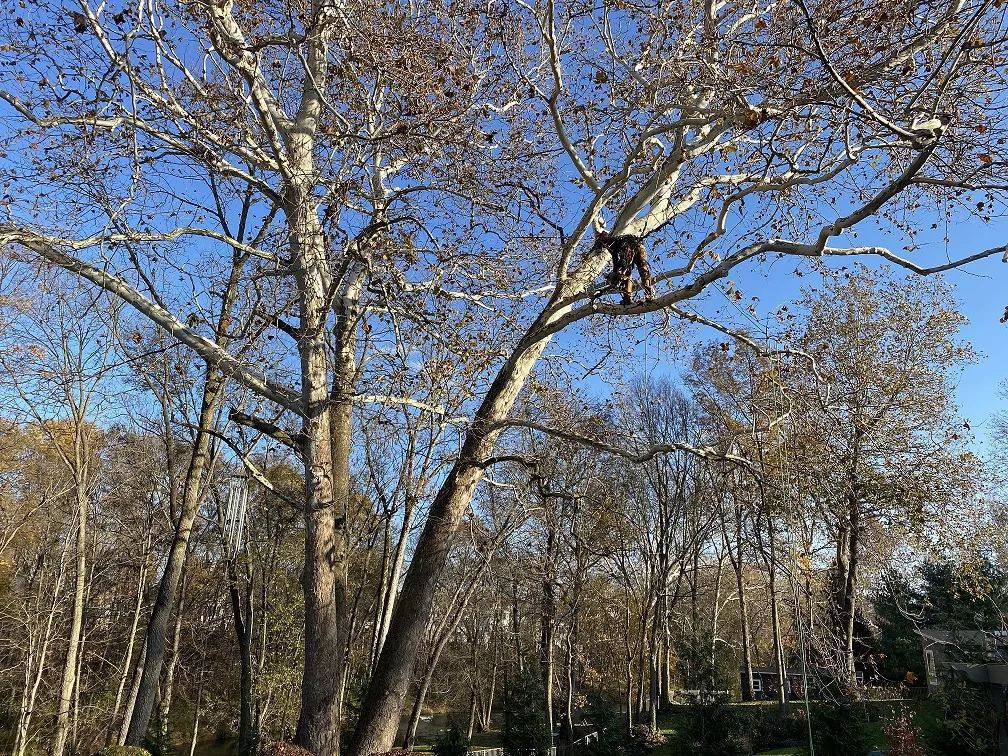Pruning your trees is an important part of caring for them. Pruning (or trimming) encourages a tree’s growth, increases its health, and improves the appearance of not only the tree, but your entire landscaped property. Not to mention, it can boost the plant’s production of fruit and flowers. Find out why pruning trees in the winter is recommended by expert tree trimming services like Reaching Higher.
What is Tree Pruning (Trimming)?
Tree pruning, or trimming, primarily involves the removal of dead or dying branches injured by disease, insects, or other external causes. An effective pruning involves the removal of branches that are too close together or in contact, eliminating branch stubs, and maintaining a well-proportioned tree shape and density – leaving the tree with adequate room to thrive and grow. Trimming also prevents dangerous overgrowth that might cause damage to your home or to nearby structures.
When is the Best Time for Tree Trimming?
Many homeowners are unaware that winter is the best time to to trim trees. Winter offers a unique opportunity for tree care that other seasons don’t.
Pruning trees in the winter ensures that your trees will get their best start come spring, keeping them healthy throughout the warmer months.
Why Should You Prune Your Trees in the Winter?
Trees naturally go through a dormant period, which typically starts in late November and peaks in February and March. During this time, trees do not actively grow or produce leaves.
The dormant of trees during winter months presents the perfect opportunity to prune trees, for several reasons:
More Visibility
One of the most apparent benefits of pruning trees in the winter is bare branches. These make it easier for arborists to assess the interior of the tree canopy and its branching structure, identifying any areas that need attention. For example, dead or damaged branches can be removed more easily when leaves have dropped off.
Safety First
One of the primary reasons for pruning your trees in the winter is safety. Overgrown branches can often obstruct paths or driveways. These can especially be dangerous during the winter, when ice and snow make it difficult to maneuver.
Additionally, if a tree has large dead or broken branches, it is more susceptible to breakage from high winds or stormy weather. This can be hazardous to homeowners and can cause property damage.
Healthy Growth
Because pruning removes dead or diseased branches, it ensures that there is plenty of room for new buds and leaves to grow in their place – thereby stimulating the growth of your trees throughout the spring and summer months. The pruning process also opens up tree canopies, allowing light and air to enter all parts of the crown. More light means more flowers, leaves, and fruits. In addition to thicker foliage, the increased light and airflow also reduce moisture and potential disease caused by bacteria and fungal pathogens.
Any trees trimmed during their winter dormancy will also heal and recover much more quickly due to the onset of their seasonal growth cycle.
Pest Control
Winter pruning can help to eliminate pests or insects that may have taken up residence over time. By cutting away any infested stems or branches early on – including crossing branches that have rubbed against each other and developed wounds — you can prevent pest problems from getting out of control. This can save both time and money down the line.
While they are dormant, trees are also less vulnerable to diseases associated with pruning cuts (e.g. oak wilt). These cuts can often provide an entryway to pathogens during warmer months.
What Trees Should Be Trimmed in the Winter?
The majority of deciduous tree species should be trimmed in the late winter. However, winter isn’t always the best time for tree trimming: Some trees should be pruned only after they’ve already bloomed in the spring or summer. Trimming them too early in the season can damage or remove buds, drastically reducing the number of flowers that appear during bloom time. Examples are magnolia, redbud, lilacs, juneberry, and azalea trees.
Furthermore, trees that bloom early in the growing season should typically be pruned immediately after they finish blooming. Non-flowering trees should be pruned in the spring, before they begin to grow.
While most evergreens (e.g. pine and fir) require very little pruning, they can benefit from being properly trimmed according to their specific growth cycles. Spruce can be pruned in the late winter, as can arborvitae, cypress, juniper, yew, and hemlock.
It may be necessary to trim any tree species for safety reasons – for example, if it suffers from hazardous dead branches or hanging limbs.
Common Trees That Should Be Pruned in the Winter:
- Oak
- Maple
- Elm
- Walnut
- Apple
- Hawthorne
- Ash
- Mountain ash
- Butternut
- Birch
- Beech
- Ironwood
- Linden
Let Us Help You with Pruning Your Tree This Winter!
With timely care and regular maintenance, you can keep your landscape looking its best year-round. If you live in Lancaster or Chester County, Pennsylvania and are considering pruning your trees, contact Reaching Higher. – a professional tree pruning service with over 16 years of experience. Our skilled staff has years of experience in the tree care industry and is well equipped to provide the best possible care for your trees — even in locations that are hard to access.
